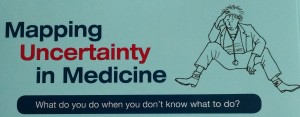My colleague was facing a WDYDWYDKWTD situation. A young man came with his mother. He used to be continent at night when he was small, but now asked why he had been wetting the bed for the last 12 years straight and could the doctor please sort it out? Outside the familiar territory of enuresis in small children, things seemed more puzzling.
Let us think this one through;
Is the diagnosis the problem, or, is the diagnosis known, but the treatment and care the issue? My colleague didn’t know how to treat the problem because the diagnosis was not clearly understood…enuresis is really a symptom not a complete diagnosis. This places us firmly in the ANALYSING QUADRANT of the Map of Uncertainty in Medicine.
With many common symptoms we rely on quick, intuitive thinking to help us work out what to do. This is sometimes called heuristics or “rules of thumb”. This approach was not working for my colleague, who seemed a bit paralysed. This can be due to internal factors (an unfamiliar situation perhaps, a lack of confidence that this “can be worked out”, or cognitive fatigue after a long day) or to external factors (too much work today, someone else needs the room). Sometimes patient factors play a part too and this patient seemed reluctant to give much history or explanation of the issues. Was there some other problem going on that he didn’t want to talk about in front of his mum?
Clearly, an intuitive approach wasn’t working, so how about a type 2 deliberative, methodical working out? The psychological cost of switching from type 1 to type 2 thinking can be high. It takes a lot of effort to work things out systematically and this may not seem attractive if time, stamina or resources are in short supply.
In many situations like this clinicians resort to “dysfunctional ways out”…for example, “see a male GP”, or,”refer to someone else as soon as possible” or focus on only one aspect of the problem ( the bed is wet, let’s just use some anticholinergic tablets to dry up the urine) without fully analysing the whole problem. This is risky; these approaches may not solve the problem…the referral may go to the wrong service and be bounced back, or the anticholinergics may trigger side effects like constipation, worsening the problem and causing the patient to lose confidence or trust.
So what skills would help here? The first thing is probably to resort to traditional (Type 2 thinking) clinical reasoning, using a hypothetico-deductive method. Which system could be involved here and how would one tests the hypotheses that arise? Is the problem that the bladder can’t hold the urine, (too small? too much urine? Too deep sleep? Alcohol? Drugs? Infection?). Or is it that too much urine is being produced (diabetes? renal failure? Diabetes insipidus? Too much tea?) . Perhaps the control of the bladder by the nervous system is inadequate? (a neurological or sleep problem? Failure of bladder training? A psychological or traumatic event?)
In case the relevant questions tests and investigations do not help much, it helps to consistently maintain a wider view of the patient. What are the emotional, psychological and social issues here? How is the wet bed affecting him, or other family members? How has he come to consult now when the problem has been there for so long, unmentioned? Finding out how a typical night goes for him might reveal a lot.
This approach may yield a diagnosis, more likely it will yield several possibilities. If they can’t readily be resolved with Primary Care investigations then a referral may be needed….and then the skills of the NETWORKING QUADRANT of the Map of Uncertainty in medicine will come into play. We will turn to the skills of the NETWORKING QUADRANT another day….
